|
- Team Durango DETC410 -
WORDS & PHOTOS BY JOEL NAVARRO
1/10-SCALE 4WD COMPETITION TOURING CAR | KIT
Durango’s first-ever touring car is a pro-grade performer
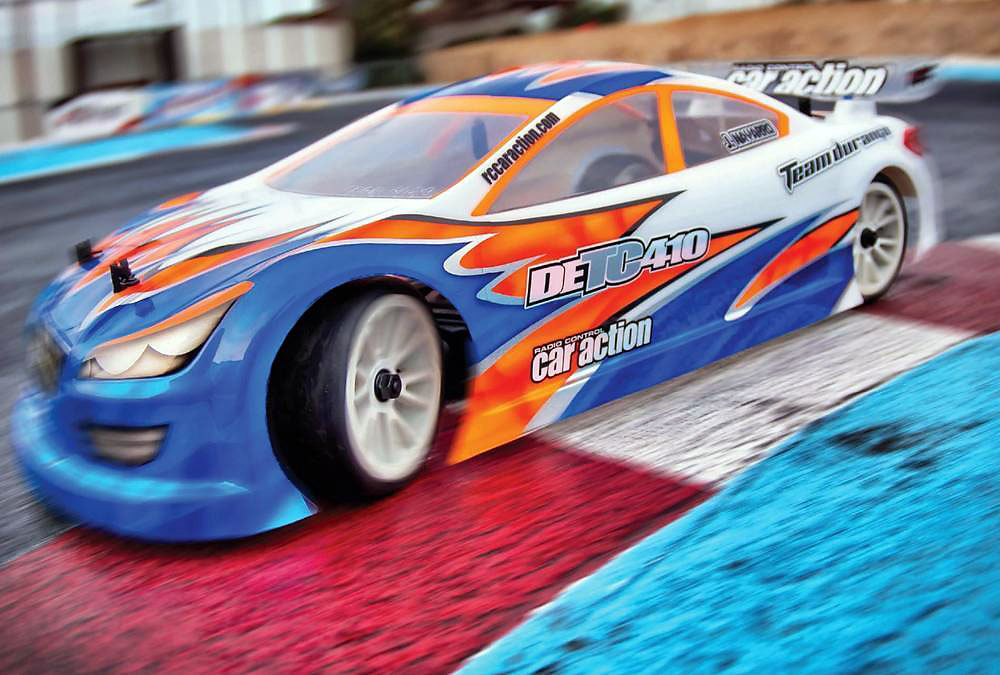
Team Durango has made a name for itself in the RC world as a manufacturer that produces ultra high-quality performance vehicles that are successful in the national and world championship arenas. Off-road vehicles has been the company’s primary focus until now. Durango is hitting the pavement hard with its first sedan offering and it’s packed with features that put it up to par with its off-road siblings and the other high end sedans on the market. With a double deck carbon chassis, fully adjustable suspension and two belt drivetrain design, the DETC410 aims to dominate tracks around the globe.
DUAL-BELT DIFF AND SPOOL DRIVETRAIN
The DETC410 spins a pair of belts to deliver 4WD, and mounts the spur gear between the layshaft pulleys to hold the motor close to the chassis’ centerline. The bevel-gear rear differential uses plastic gears to reduce the rotating mass, and the diff case is sealed to hold silicone oil. Durango leaves oil selection to you, and does not include any with the kit. Up front, a solid spool takes the place of a front diff, so both front wheels receive equal power at all times. CV-joint driveshafts are fitted front and rear, and pair their hardened steel joints with lightweight aluminum dogbone shafts. The front shafts have unique, double universal joints for better efficiency and improved steering throw. Sleeves on the drive pins reduce friction between the drive pins and drive cups to smooth out the drivetrain, and the completed belt-drive system is indeed slick.
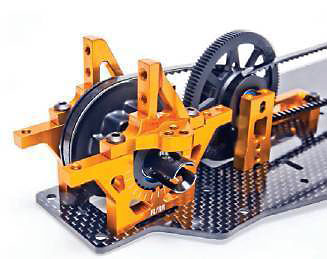
Here you can see how the dual-belt setup sandwiches the spur gear between the belts. Note the indexed, eccentric bearing mount used to set belt tension.
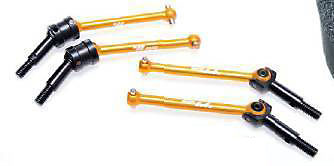
Aluminum shafts with steel CV joints spin the wheels. The “D-Joint” front shafts have double universal joints, and the rear CVs have a unique cutaway design instead of a full “bell” surrounding the joint.
ULTRA-TUNABLE SUSPENSION
The DETC adjustability required a competition car. The threaded-body aluminum dampers can be built as emulsion style shocks or use bladder compensation to make up for oil displacement when the shock shafts are compressed. When building the shocks you have the option to use one or two silicone o-rings to seal the bottom end; one will make the shock ultra smooth while two will do a better job of sealing the body. Aluminum hinge pin mounts secure the suspension arms to the chassis and they incorporate plastic inserts that allow you to change rear toe angle from -4 to +4 degrees in half-degree increments. Inserts are also used in the hub carriers to set front caster, and turnbuckles set front camber and toe. Durango also equips the car with front and rear swaybars, so you have plenty of options to suit any track.
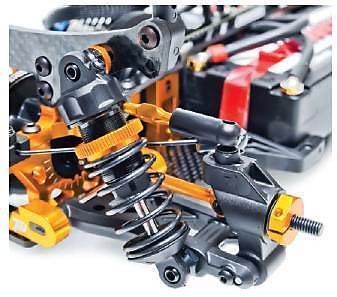
Clamping hex hubs, threaded shocks, carbon fiber towers… all the comp-grade stuff you’d expect.
Note the hole in the ball cup that allows you to remove the ball stud without popping off the cup.
LOW-PROFILE CARBON FIBER AND ALUMINUM CHASSIS
The DETC410 looks every bit the pro-caliber machine it is, with a heaping-helping of gold-anodized machined aluminum set off by the woven carbon-fiber chassis parts. The main chassis is 2.25mm thick and is symmetrical from left to right so it has equal flexibility whether cornering left or right. The slim top deck gives the car fore-and-aft stiffness to transfer power efficiently, and can be tuned for torsional flex by varying the number of screws used to secure to the center, front, and rear bulkheads. The aluminum bulkheads further stiffen the chassis, and the parts are heavily machined to remove unnecessary material and the weight that goes with it. The electronics are mounted as close to the car’s centerline as possible for sharp transitional handling, and a pair of minimalist brackets retain the battery. As a pure race car, the 410 skips Velcro straps or mechanical hold-downs to restrain the pack in favor of strapping tape, which trims weight and holds the pack tightly.
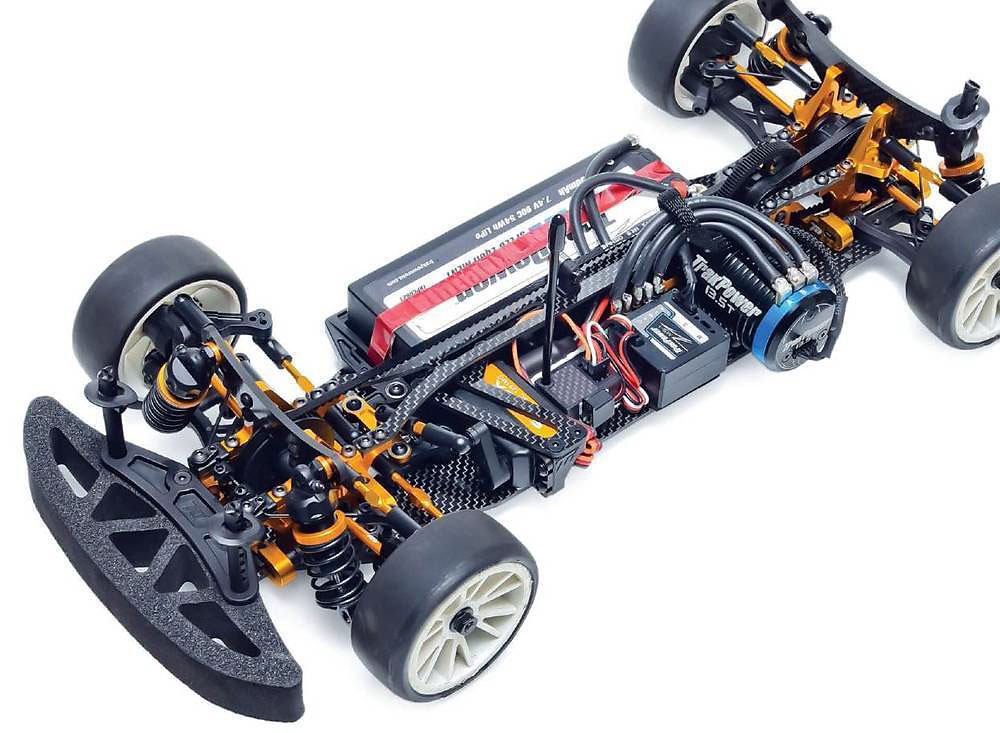
The narrow graphite chassis leaves no room to spare, and holds all the electronic gear close to (or over) its sides.
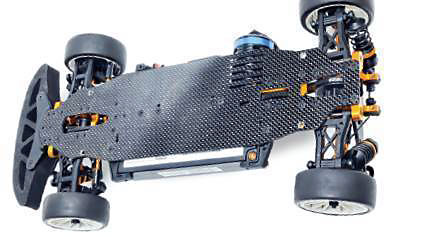
The chassis plate is symmetrical from left to right for consistent torsional flex.
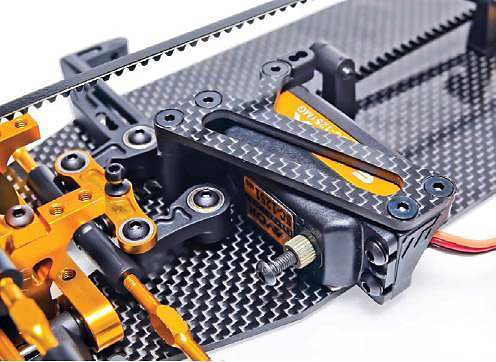
Instead of mounting the servo directly to the main chassis, which can cause the chassis to flex under steering loads, the servo is suspended from above by a “floating” mount.
TEST GEAR TrakPower MS Series Brushless System
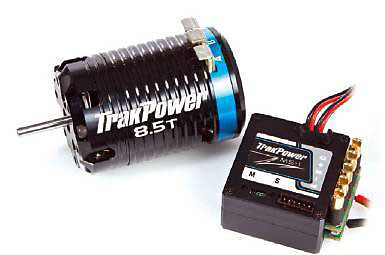
For power I turned to TrakPower and its MS series brushless system. The sensored system is a speed control and motor combo and you can choose from a 6.5, 8.5, 10.5 13.5 17.5 or 21.5 turn motor when purchasing it. The 100A MS-1 speed control features easy to access gold plated solder posts and a an aluminum case to reduce operating temps. Adjustment parameters allow you to change the drive mode, motor direction, neutral width, start power and drag brake. I went with a 13.5-turn motor to run my car and it features a ribbed can for increased cooling, mechanical timing and heavy duty solder tabs for the wires.
BEHIND THE WHEEL
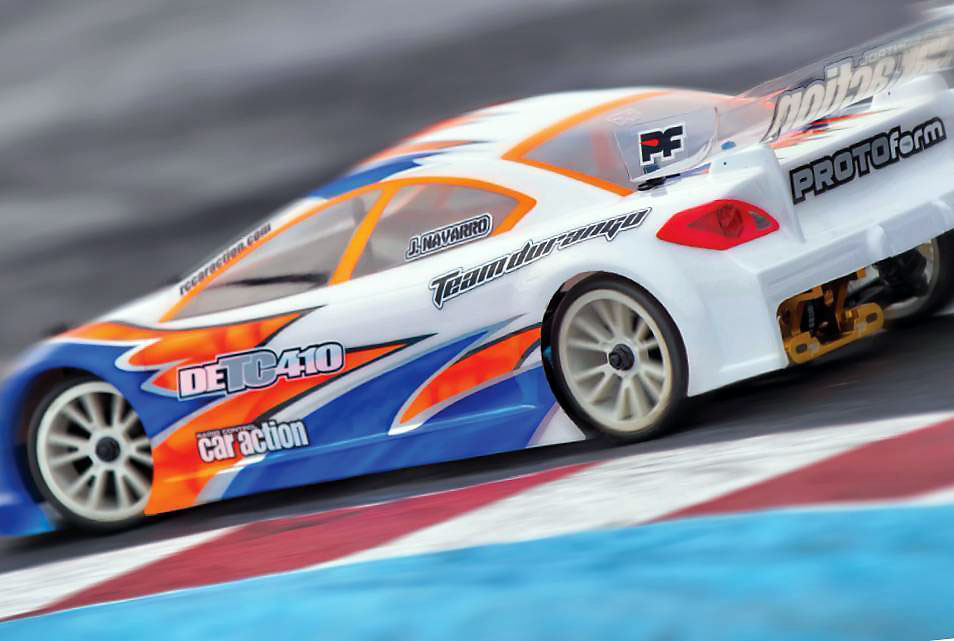
The DETC410 was a dream to build thanks to its easy to understand and comprehensive instruction manual and excellent parts package labeling that correctly corresponded to a step in the manual. With the build complete I decided to head to CRaceway in Orange, CA to burn some rubber. I didn’t want to show on race day with no practice, so I decided to go the Friday before for open practice. Some of the locals were already practicing when I arrived and I immediately noticed that the grip was way up on the newly resurfaced asphalt. The track layout had a bit of everything as far as fast sweeping turns, 180’s and switchback chicanes; perfect conditions to put the DETC410 through its paces. As the tires started to scrub into the suspension settings on the first few laps, the DETC410’s responsiveness started to increase. If a drivetrain on a vehicle is quiet, it means it’s efficient and the DETC410 was very silent on the track. All I heard was the scream of the motor and the tires scrubbing in the turns. The TrakPower 13.5-turn brushless motor powered the DETC410 out of turns like a rocket onto the long back straightaway. The box-stock setup on the DETC410 made it perform well on the track, but I could tell the setup was playing it safe. It allowed a moderate amount of push in medium and small radius turns, which in turn made for an easy to drive car that turned in respectable lap times. In search of faster lap times, I decided to bring the DETC410 back to the pits for some suspension tweaks. The rear end had more than enough traction and I needed more steering so I decided to start small and move the rear shocks out one hole on the shock tower. Back on the track, the small change was immediately noticeable with an increased amount of steering. Corner speed was exceptionally good around small and medium sized turns with excellent initial steering entering a corner. I like my sedan to have ultra aggressive responsive steering. With wrench in hand, I quickly loosened the rear droop screws a half turn which added approximately 1mm of rear up travel for a total of 5mm. On the next run, the steering feel remained the same, but with the added rear up travel more weight was allowed to transfer to the front tires making the DETC410 turn in quicker when entering a corner. After running half a dozen packs, I thought the handling was perfectly suited to my driving style and was ready to tackle my first race day with the DETC410.
FINAL WORD
Over the years I’ve had a chance to drive most of Durango’s line of offroad vehicles and I have never been disappointed, so I had high expectations for their sedan. Even though the DETC410 is Durango’s first ever on-road offering, they got it right. The DETC410 is a great performer out of the box and is very easy to drive fast, though I would like to see diff and shock oils included for those customers not already stocked with the right fluids. At $400, the DETC410 carries a price tag that is on par with the rest of its counterparts in the competition touring scene, and includes lots of trick parts that make it feel several steps higher than an average sedan.
+ Highly tunable suspension
+ Top shelf materials used throughout
+ Stock setup is competitive right out of the box
+ Excellent instruction manual
- Shock and diff oils not included
- Wheels not included
VEHICLE SPECS
- Item no.: DETC410
- Scale: 1/10
- Price: $400
- Weight, as tested 3 lb 13 oz (1420g)
CHASSIS
- Material: 2.25mm carbon fiber plate
- Type: Double-deck plate
SUSPENSION
- Type: H-arm with aluminum turnbuckle upper link
- Inboard camber link positions (F/R): 3/3
- Outboard camber link positions (F/R): 1/3
- Shock positions, towers (F/R): 6/6
- Shock positions, arms (F/R): 3/3
SHOCKS
- Bodies: Threaded aluminum, 11mm bore
- Shafts: Plated steel, 3mm
- Volume compensation: Bladder or emulsion
DRIVETRAIN
- Type: 4WD belt
- Spur gear/pinion: 116T / Not Included (64 pitch)
- Differential F/R: Spool/Sealed bevel plastic gear
- Driveshafts F/R: Aluminum CV-style/Aluminum CV-style
- Bearings: Rubber shielded ball
REQUIRES
- 2-channel radio system, speed control, motor, steering servo,
- battery, body, wheels and tires
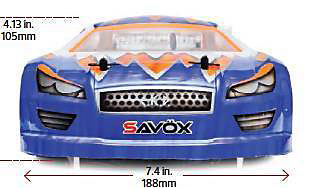 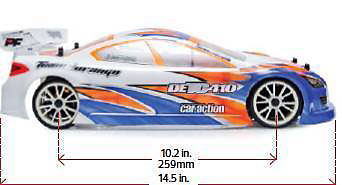
TEST GEAR (NOT INCLUDED)
- Radio: Futaba 4PKS
- Servo: Savox SC-1251 MG
- Speed Control: Trakpower MS-1
- Motor: Trakpower 13.5T Sensored Brushless
- Body: Protoform P37-R
- Wheels/Tires: Solaris Premounted Medium Compound
- Battery: Trakpower 7200 mAh 7.4V 90C LiPo
- Charger: Hitec X4 AC Plus
SOURCES
- Durango team-durango.com
- Hitec hitecrcd.com
- Protoform racepf.com
- Trakpower trakpowerusa.com
- Savox savoxusa.com
- Solaris solarisrp.com
- Spektrum spektrumrc.com
|
